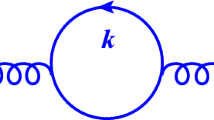Abstract
The hypothesis of gauge/gravity correspondence (or holographic duality) from string theory has led to unexpected and challenging ways for description of strongly coupled systems. Such descriptions are given in terms of weakly-coupled higher-dimensional gravitational theories. The holographic ideas have penetrated to many branches of physics. We discuss motivations for the so-called Soft Wall holographic approach to non-perturbative strong interactions and its advantages over other holographic approaches.
Similar content being viewed by others
REFERENCES
J. M. Maldacena, Adv. Theor. Math. Phys. 2, 231–252 (1998);
J. M. Maldacena, Int. J. Theor. Phys. 38, 1113 (1999).
E. Witten, Adv. Theor. Math. Phys. 2, 253–291 (1998).
S. S. Gubser, I. R. Klebanov, and A. M. Polyakov, Phys. Lett. B 428, 105–114 (1998).
J. Erlich, E. Katz, D. T. Son, and M. A. Stephanov, Phys. Rev. Lett. 95, 261602 (2005).
L. Da Rold and A. Pomarol, Nucl. Phys. B 721, 79–97 (2005).
J. Hirn and V. Sanz, J. High Energy Phys. 12, 030 (2005).
A. Pomarol and A. Wulzer, Nucl. Phys. B 809, 347 (2009).
R. Sundrum, Phys. Rev. D 86, 085025 (2012).
J. Polchinski and M. J. Strassler, Phys. Rev. Lett. 88, 031601 (2002).
A. Karch, E. Katz, D. T. Son, and M. A. Stephanov, Phys. Rev. D 74, 015005 (2006).
R. Casero, E. Kiritsis, and A. Paredes, Nucl. Phys. B 787, 98 (2007).
U. Gursoy and E. Kiritsis, J. High Energy Phys. 02, 032 (2008).
U. Gursoy, E. Kiritsis, and F. Nitti, J. High Energy Phys. 02, 019 (2008).
I. Iatrakis, E. Kiritsis, and A. Paredes, J. High Energy Phys. 11, 123 (2010).
S. S. Afonin, Phys. Lett. B 719, 399–403 (2013).
S. S. Afonin and T. D. Solomko, Eur. Phys. J. C 82, 195 (2022).
S. S. Afonin, Int. J. Mod. Phys. A 25, 5683 (2010).
S. S. Afonin, Adv. High Energy Phys. 2017, 8358473 (2017).
S. S. Afonin, A. A. Andrianov, V. A. Andrianov, and D. Espriu, J. High Energy Phys. 04, 039 (2004).
K. A. Mamo and I. Zahed, (2022). arXiv:2106.00752v3 [hep-ph].
S. J. Brodsky, G. F. de Teramond, H. G. Dosch, and J. Erlich, Phys. Rep. 584, 1 (2015).
Funding
This research was funded by the Russian Science Foundation grant no. 21-12-00020.
Author information
Authors and Affiliations
Corresponding author
Ethics declarations
The authors declare that they have no conflicts of interest.
Rights and permissions
About this article
Cite this article
Afonin, S., Solomko, T. Motivations for the Soft Wall Holographic Approach to Strong Interactions. Phys. Part. Nuclei 54, 1022–1024 (2023). https://doi.org/10.1134/S1063779623060035
Received:
Revised:
Accepted:
Published:
Issue Date:
DOI: https://doi.org/10.1134/S1063779623060035




